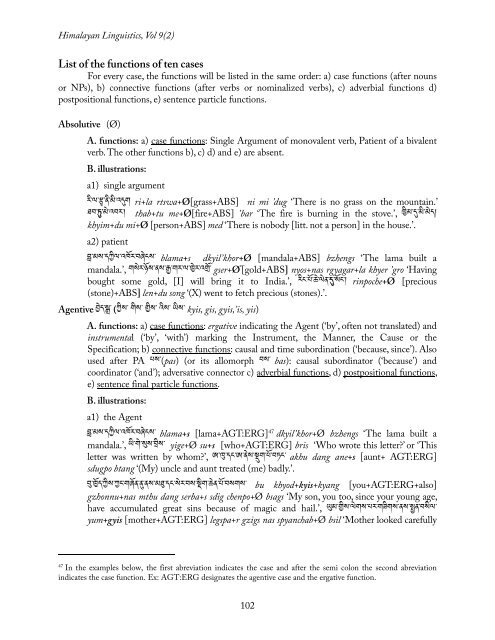The Classical Tibetan cases and their transcategoriality
The Classical Tibetan cases and their transcategoriality
The Classical Tibetan cases and their transcategoriality
You also want an ePaper? Increase the reach of your titles
YUMPU automatically turns print PDFs into web optimized ePapers that Google loves.
Himalayan Linguistics, Vol 9(2)<br />
List of the functions of ten <strong>cases</strong><br />
For every case, the functions will be listed in the same order: a) case functions (after nouns<br />
or NPs), b) connective functions (after verbs or nominalized verbs), c) adverbial functions d)<br />
postpositional functions, e) sentence particle functions.<br />
Absolutive (Ø)<br />
A. functions: a) case functions: Single Argument of monovalent verb, Patient of a bivalent<br />
verb. <strong>The</strong> other functions b), c) d) <strong>and</strong> e) are absent.<br />
B. illustrations:<br />
a1) single argument<br />
རི་ལ་རྩྭ་ནི་མི་འདུག ri+la rtswa+Ø[grass+ABS] ni mi ’dug ‘<strong>The</strong>re is no grass on the mountain.’<br />
ཐབ་ཏུ་མེ་འབར་། thab+tu me+Ø[fire+ABS] ’bar ‘<strong>The</strong> fire is burning in the stove.’, ཁྱིམ་དུ་མི་མེད།<br />
khyim+du mi+Ø [person+ABS] med ‘<strong>The</strong>re is nobody [litt. not a person] in the house.’.<br />
a2) patient<br />
བླ་མས་དཀྱིལ་འཁོར་བཞེངས་ blama+s dkyil’khor+Ø [m<strong>and</strong>ala+ABS] bzhengs ‘<strong>The</strong> lama built a<br />
m<strong>and</strong>ala.’, གསེར་ཉོས་ནས་རྒྱ་གར་ལ་ཁྱེར་འགྲོ་ gser+Ø་[gold+ABS] nyos+nas rgyagar+la khyer ’gro ‘Having<br />
bought some gold, [I] will bring it to India.’, རིང་པོ་ཆེ་ལེན་དུ་སོང་། rinpoche+Ø [precious<br />
(stone)+ABS] len+du song ‘(X) went to fetch precious (stones).’.<br />
Agentive བྱེད་སྒྲ་ (ཀྱིས་ གིས་ གྱིས་ འིས་ ཡིས་ kyis, gis, gyis,’is, yis)<br />
A. functions: a) case functions: ergative indicating the Agent (‘by’, often not translated) <strong>and</strong><br />
instrumental (‘by’, ‘with’) marking the Instrument, the Manner, the Cause or the<br />
Specification; b) connective functions: causal <strong>and</strong> time subordination (‘because, since’). Also<br />
used after PA པས་(pas) (or its allomorph བས་ bas): causal subordinator (‘because’) <strong>and</strong><br />
coordinator (‘<strong>and</strong>’); adversative connector c) adverbial functions, d) postpositional functions,<br />
e) sentence final particle functions.<br />
B. illustrations:<br />
a1) the Agent<br />
བླ་མས་དཀྱིལ་འཁོར་བཞེངས་ blama+s [lama+AGT:ERG] 47 dkyil’khor+Ø bzhengs ‘<strong>The</strong> lama built a<br />
m<strong>and</strong>ala.’, ཡི་གེ་སུས་བྲིས་ yige+Ø su+s [who+AGT:ERG] bris ‘Who wrote this letter?’ or ‘This<br />
letter was written by whom?’, ཨ་ཁུ་དང་ཨ་ནེས་སྡུག་པོ་བཏང་ akhu dang ane+s [aunt+ AGT:ERG]<br />
sdugpo btang ‘(My) uncle <strong>and</strong> aunt treated (me) badly.’.<br />
བུ་ཁྱོད་ཀྱིས་ཀྱང་གཞོན་ནུ་ནས་མཐུ་དང་སེར་བས་སྡིག་ཆེན་པོ་བསགས་ bu khyod+kyis+kyang [you+AGT:ERG+also]<br />
gzhonnu+nas mthu dang serba+s sdig chenpo+Ø bsags ‘My son, you too, since your young age,<br />
have accumulated great sins because of magic <strong>and</strong> hail.’, ཡུམ་གྱིས་ལེགས་པར་གཟིགས་ནས་སྤྱན་བསིལ་<br />
yum+gyis [mother+AGT:ERG] legspa+r gzigs nas spyanchab+Ø bsil ‘Mother looked carefully<br />
47 In the examples below, the first abreviation indicates the case <strong>and</strong> after the semi colon the second abreviation<br />
indicates the case function. Ex: AGT:ERG designates the agentive case <strong>and</strong> the ergative function.<br />
102
















